ICSE Class 10 Biology Fundamentals of Genetics Questions and Answers
ICSE SolutionsSelina ICSE Solutions
APlusTopper.com provides ICSE Solutions for Class 10 Biology Chapter 2 Fundamentals of Genetics for ICSE Board Examinations. We provide step by step Solutions for ICSE Biology Class 10 Solutions Pdf. You can download the Class 10 Biology ICSE Textbook Solutions with Free PDF download option.
Download Formulae Handbook For ICSE Class 9 and 10
Short Questions
Question 1: What is a gene ? How is it related to heredity ?
Answer: Genes are hereditary units located on a chromosomal thread. A gene can be defined as “ultimate unit of recombination, mutation and self-reproduction”. They are responsible for various characteristics externally shown by the plants and animals. A single gene may affect one or more characteristics of offsprings.
Question 2: Define mutation and give its significance.
Answer: Any change in genetic composition of an individual brought about by internal or external factors is called mutation. Mutation play a significant role in the evolution and speciation because they cause variability. However, some harmful mutations cause diseases.
Question 3: What is crossing-over ? What are the factors affecting it ?
Answer: Crossing-over is the interchange of the parts of the chromatid of a pair of chromosomes. High temperature, X-rays and radiation treatment are the factors affecting crossing-over.
Question 4: Why did Mendel selected pea plants for his experiment ?
Answer: Mendel selected pea plants for his experiment because of the following reasons :
- A pea plant has many contrasting characters.
- Self-fertilization takes place in pea plants and so it is possible to get a pure line of traits.
- Flowers are bisexual and hermaphrodite. Therefore, cross pollination is achieved easily.
Question 5: Define Mendel’s law of segregation.
Answer: Law of Segregation or the law of purity of gametes : The two members of a pair of factors separate during the formation of gametes. They do not blend but segregate or separate into different gametes. The gametes combine together by random fusion at the time of zygote formation.

Question 6: What is monohybrid cross ? How did Mendel performed this cross ?
Answer: Monohybrid cross : It is a cross where two forms of a single trait are crossed or hybridized.
Mendel performed this experiment on pea plant. He crossed the true breeding forms of tall and dwarf plants and obtained the hybrid progeny. This is called as first generation (F1) offspring plant to self-pollinate and produced the second generation (F2).
Question 7: A certain couple got four daughters in a sequence and no son. Does it mean that the husband does not produce Y-chromosome bearing sperms ? Explain.
What is the chance of this couple having a daughter ?
Answer: Daughter or son is a matter of chance for Y- or X-chromosome carrying sperm to fertilize the egg. It is always 50% The couple got four daughters as a matter of chance encounter of the X-chromosome carrying sperm fertilizing the eggs. The chance of the couple getting another daughter is again 50% (so is for the son).
Question 8: Mutation alerts the hereditary material. Give reasons.
Answer: Mutation alerts the hereditary materiel of an organisms cell and result into change in certain characters of traits. For example:
(a) Sickle-cell anemia, is a blood disease caused by gene mutation. The mutation causes change in the DNA which controls productivity of RBCs.
(b) Radioactive radiations also alter the gene structure and their effects can be seen generation after generation.
Question 9: Why do men suffer from haemophilia and colour blindness ? Under what conditions do women suffer from these disorders ?
Answer: Haemophilia and colour blindness are sex-linked disorders, caused by recessive genes located on X-chromosome. These disorders occur more frequently in men because males are heterozygous for the defect. They have one X-chromosome and one Y-chromosome. Y- chromosome does not carry alleles for these traits, therefore the recessive genes are able to express even in single dose.
Females have two X-chromosomes therefore both the alleles have to be present in recessive form to be able to be expressed. Thus, females suffer only if they are homozygous for the trait which is possible only when a carrier or sufferer female marries a sufferer male.
Give Reasons
Question 1: Law of independent assortment holds good for the gene pairs that occur in different pairs of chromosomes.
Answer: It is chromosome and not the individual gene which segregate during gamete formation.
Question 2: Heritable variations are called genetic variations.
Answer: Because these variations arise due to change in the genetic material of germplasm or gametes.
Question 3: Discontinuous variations are inheritable.
Answer: Because these are produced by the effects of environment.
Question 4: Why X-linked recessive diseases are more common among males than females.
Answer: Because females have two copies of the X-Chromosome and males have only one X- chromosome.
Question 5: In honey bee, female is diploid and male is haploid.
Answer: Because in honey bee the fertilized diploid egg develops into a female but on unfertilized haploid egg develops into male.
Question 6: Haemophilia shows criss-cross inheritance.
Answer: The gene that causes haemophilia is recessive and lies in the X-chromosomes.
Differentiate
Question 1: Homozygous and Heterozygous.
Answer:
| Homozygous | Heterozygous |
| An individual having two identical alleles (alternative form of the same gene) is known as homozygous. | An individual having two different alleles is known as heterozygous. |
Question 2: Y-linked inheritance and X-linked inheritance.
Answer:
| Y-linked inheritance | X-linked inheritance |
| There are certain traits like baldness or hyperstrichory that occur in male but not in female because the dominant genes controlling these traits are found on the Y chromosome, which is present only in males. | Certain inherited defects such as colour blindness and haemophilia are far more common in males than in females because these defects are due to recessive genes and both genes occur on the X-chromosome. |
Question 3: Haemophilia and Colour blindness.
Answer:
| Haemophilia | Colour blindness |
| Haemophilia is a X-linked inheritance. It is a recessive character in which individuals suffering with disease lack of factor responsible for clotting of blood. | In this inheritance the gene of red, green colour blindness is located. on X-chromosome so the person is unable to differentiate between the red and green colour. |
Question 4: Genotype and Phenotype.
Answer:
| Genotype | Phenotype |
| It designates the genetic constitution of an individual which determines the characters. The individuals of the same genotype interbreed and have the same phenotype if they are present in the same environment. | It designates the external appearance of an individual. The individual of the same phenotype may appear alike but may not inter breed if genetically different. |
Question 5: Monohybrid and Dihybrid cross.
Answer:
| Monohybrid | Dihybrid |
| Crosses involving a single pair of alleles. It yields a phenotypic ratio of 3 : 1 in F2 generation. | Crosses involving two pairs of alleles. It yields a phenotypic ratio of 9 : 3 : 3 : 1 in F2 generation. |
Diagram Based Questions
Question 1: (i) State Mendel’s Law of Dominance.
(ii) A pure tall plant (TT) is crossed with a pure dwarf plant (tt).
Draw Punnet squares to show (1) F2 generation (2) F2 generation.
(iii) Give the Phenotype of the F2 generation.
(iv) Give the Phenotyic and Genotypic ratio of the F2 and F2 generation.
(v) Name any one X-linked disease found in humans.
Answer: (i) Law of Dominance: Out of a pair of contrasting characters present together, one is able to express itself while the other remains suppressed.

(iii) In F2 generation 75% plants will be tall and 25% dwarf.
(iv) F1: Phenotypic ratio—all tall plants.
Genotypic ratio—all hybrids.
F2: Phenotypic ratio—3:1
Genotypic ratio—1:2:1
(v) Haemophilia.
Question 2: Write a short note on sex determination in man.
Answer: The difference between two individuals of same species with respect to heredity is known as sex. So, an individual can either be a male or female in normal circumstances. Scientists have discovered that sex is transmitted by definite sex- chromosomes, also called heterosomes. The human body cells have two sex- chromosomes. A woman has two X- chromosomes while a man has one X- chromosome and one Y-chromosome.
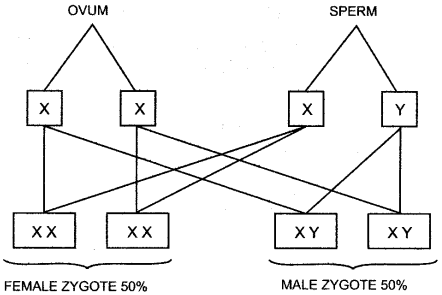
Therefore, an egg cell has one X- chromosome and a sperm cell has either an X- or a Y-chromosome. This means that the sex of a baby is determined by the type of sperm cell fertilizing the egg. If a egg, fused with a sperm having Y-chromosome, then the male zygote will develop and when fused with a sperm having X-chromosome then a female zygote will develop.
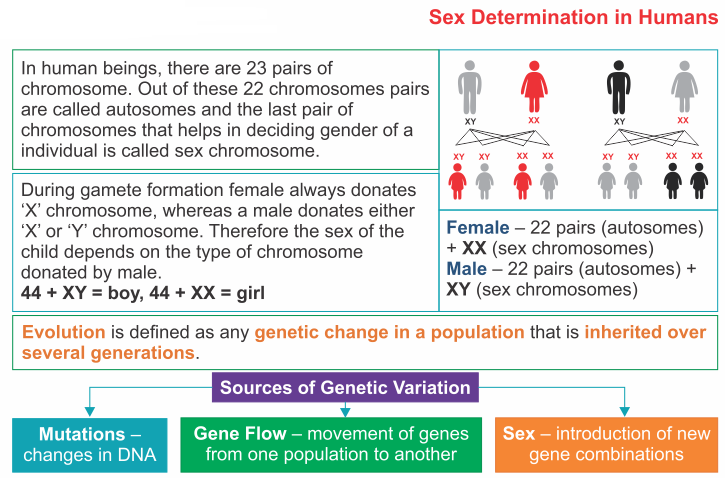
Question 3: A woman with normal vision marries a man with normal vision. They have a colourblind son. Her husband dies and she marries a colourblind man. Show the type of children that might be expected from this marriage and the proportion of each.
Answer: In the first marriage of woman the son was colourblind therefore the woman is a carrier genotype of that Woman: XX
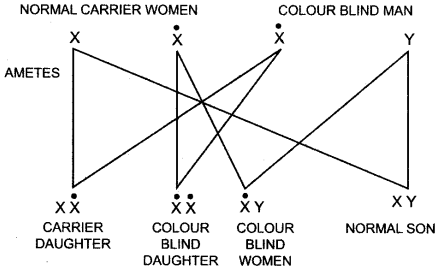
Since the man in the second marriage was colourblind.
Genotype of that man: XY
Possible combination of this marriage.

Question 4: What is dihybrid cross ? How did Mendel performed this cross.
Answer: Dihybrid Cross: A cross between two parents taking into consideration alternative traits of two different characters. For example, a cross between round and yellow seed bearing plant with wrinkled and green seed bearing plant.

Question 5: A woman had normal vision, but her father was colourblind. She marries a man, who is colourblind.
Find out the probability of the first child being colourblind, whether it is a boy or girl.
Answer: That woman is heterozygous, and carrier of that trait because her father was colourblind. She marries a colourblind man, then it might be possible that her first child will be colourblind whether a son or a daughter, because mother and father both possess an inherited chromosome.

Question 6: The karyotype (set of chromosomes) shown below is taken from a dividing cell in a certain individual.
(i) Is the individual male or female ? Explain your answer.
(ii) How would you expect (a) a female cell and (b) sperm cell to differ in chromosome composition ?
Answer: (i) Male, because there is a Y-chromosome and an X-chromosome.
(ii) (a) A female would have two X-chromosomes and no Y-chromosome.
(b) A sperm cell would have half the number of chromosomes. 23 instead of 46. There would be only one sex-chromosome which could be either Y or X.
Question 7: (i) State Mendel’s law of Independent Assortment.
(ii) A homozygous Tall plant (T) bearing red coloured (R) flowers is crossed with a homozygous Dwarf plant (t) bearing white flowers (r):
(1) Give the Genotype and Phenotype of the F2 generation.
(2) Give the possible combinations of the gametes that can be obtained from the F2 hybrid.
(3) Give the dihybrid ratio and the phenotype of the offsprings of the F2 generation when two plants of the F1 generation above are crossed.
Answer: (i) Mendel’s law of independent assortment, states that in a dihybrid cross, the alleles of one pair segregate independently of the alleles of other pair at the time of gamete formation and the gametes assort independently at the time of zygote formation. Thus, inheritance of one ; character does not interfere, the inheritance of other character.
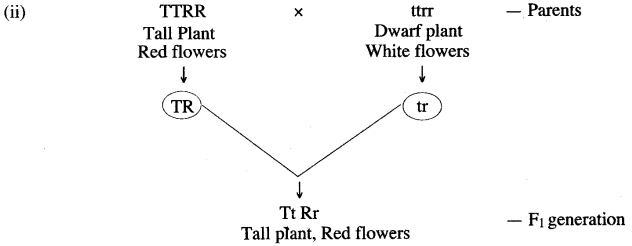
(1) Genotype — TtRr. Phenotype — All tall with red flowers.
(2) Gametes — TR, Tr, tR, tr.
(3) 9:3:3:1, 9 — Tall with red flowers, 3 — Tall with white flowers, 3 — Dwarf with red flowers, 1 — Dwarf with white flowers.
Question 8: A haemophilic man marries a carrier women. Find out the probability of their offsprings being haemophilic.
Answer: The gene of haemophilia is present on X-chromosome. This disease is only found in males and females can only act as carriers.

Question 9: Given below is a schematic diagram showing Mendel’s Experiment on sweet pea plants having axial flowers with round seeds (AARR) and Terminal flowers with wrinkled seeds (aarr). Study the same and answer the questions that follow :
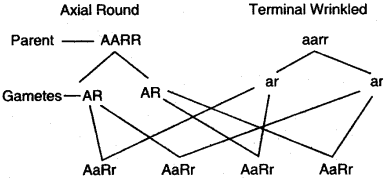
(i) Give the phenotype of F1 progeny.
(ii) Give the phenotypes of F2 progeny produced upon by the self-pollination of F1 progeny.
(iii) Give the phenotypic ratio of F2 progeny.
(iv) Name and explain the law induced by Mendel on the basis of the above observation.
Answer: (i) Axial round
(ii) Axial round, axial wrinkled, terminal round, terminal wrinkled.
(iii) 9:3:3:1
(iv) Law of independent assortment: When there are two pairs of contrasting characters, the distribution of factors of each pair in the gametes is independent of the distribution of other pair of characters.
Question 10: (a) Given below is a schematic diagram showing Mendel’s Experiment on sweet pea plants having axial flowers with round seeds (AARR) and terminal flowers with wrinkled seeds (aarr). Study the same and answer the questions, that follow :
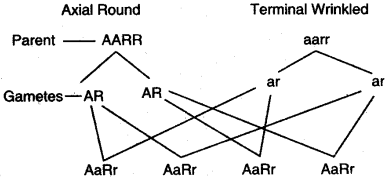
(i) Give the phenotype of F1 progeny.
(ii) Give the phenotypes of F2 progeny produced upon by the self-pollination of F1 progeny.
(iii) Give the phenotypic ratio of F2 progeny.
(iv) Name and explain the law induced by Mendel on the basis of the above observation.
Answer: (a) (i) Axial round
(ii) Axial round, axial wrinkled, terminal round, terminal wrinkled.
(iii) 9:3:3:1
(iv) Law of independent assortment: When there are two pairs of contrasting characters, the distribution of factors of each pair in the gametes is independent of the distribution of other pair of characters.
Explain the Terms
Question:
1. Heredity
2. Variation
3. Dominance
4. Linkage
5. Mutation
6. Crossing-over
7. Heterosome
8. Recessive character
9. Genotype
10. Alleles
Answer: 1. Heredity: The process of transmission of parental characters to the progeny through the generations.
2. Variation: Occurrence of differences in progeny of same parents and individuals of same species.
3. Dominance: The character expressed in first generation when any two individuals of contrasting characters breed is dominant and the phenomenon is called dominance.
4. Linkage: The phenomenon of inheritance of a group of genes together through some generations.
5. Mutation: Any change brought about into the genetic composition through external or internal factors.
6. Crossing-over: The phenomenon of the exchange of genetic material between two non¬sister chromatids.
7. Heterosome: Chromosome found in reproductive cell and which are responsible for the sex of a child.
8. Recessive character: The character which remains hidden in F1 generation and expressed in the second-generation in the ratio of 1:2:1.
9. Genotype: The genetic composition of any organism is called genotype.
10. Alleles: Alleles are the alternative forms of the same gene. For example, tallness and dwarfness are the two alternative forms of a gene for height and are called alleles. Similarly, attached ear lobes and free ear lobes are alleles for the type of ear lobes.
Name the Following
Question:
1. The study of heredity and variation.
2. Cells having a single set of chromosomes.
3. The genetic composition of an organism.
4. Pairs of chromosomes, present in human egg cells.
5. Number of chromosomes present in human gametes.
6. The diploid number for cell of man.
7. Chromatids where Recombination of characters occurs.
8. A specific part of chromosome that determine hereditary characteristics.
9. The pattern of arrangement of genes along a chromosome.
10. Pair of genes responsible for a particular characteristic.
11. The type of gene, which in the presence of a contrasting allele is not expressed.
Answer:
1. Genetics
2. Haploid
3. Genotype
4. 23
5. 23
6. 46
7. Non-sister chromatids
8. Gene
9. Linearly
10. Alleles
11. Recessive
Give Technical Terms
Question:
1. Transmission pf characters through generations.
2. Differences occurring within offsprings of the same progeny.
3. Cell organelle directly involved in genetics.
4. Cell which determines the sex of a baby.
5. A virus with DNA as heredity material.
6. The hereditary unit, which is responsible for inheritance.
7. Transmits characteristics from parents to offsprings.
8. The individual having similar pair of genes.
9. The individuals having dissimilar pair of genes.
10. The ratio of offspring on F2 generation in a dihybrid cross.
11. A single egg was fertilized by a single sperm. But twins derived from that egg were born. What is the name of such type of twins ?
12. A twin consisting of a brother and a sister were bom to a lady. What is the name of such a type of twins ?
13. Name a genetic disease in which a person cannot distinguish red and green colour.
Answer:
1. Heredity
2. Variation
3. Nucleus
4. Sperm cell
5. Retro virus e.g. HIV
6. Gene
7. Genes
8. Homozygous
9. Heterozygous
10. 9 : 3 : 3 : 1
11. Identical or monozygotic twins
12. Non-identical or fraternal twins
13. Colour blindness
Fill in the Blanks
Complete the following sentences with appropriate words :
1. The chromosomal theory of inheritance was proposed by Sutton and Boveri in 1902.
2. Gene is the hereditary unit.
3. In mammals, the female is homozygous while the male is Heterozygous.
4. A chromosome is composed of 50 % DNA and 50% histone.
5. Gregor John Mendel is the Father of Genetics.
6. The number of chromosomes in human is pairs/46.
7. The physical expression of genes is called Phenotype.
8. The small differences among individuals are called Variations.
9. The dissimilar pairs of genes present in an individual are known as Heterozygous.
10. Autosomes chromosomes do not take part in sex determination.
11. Alleles are the alternative forms of a gene producing different effects.
12. 9 : 3 : 3 : 1 is the ratio of dihybrid cross.
13. A character that is supressed is Recessive.
14. Upon Fertilization the diploid condition is restored.
True & False
Mention, if the following statements are True or False. If false rewrite the wrong statement in its correct form:
1. Most genetic diseases in man are recessive in character. (True)
2. DNA has a double helical structure. (True)
3. Genes are responsible for genetic characters. (True)
4. Linkage is a permanent feature of few genes. (True)
5. Mutation can be brought about artificially. (True)
6. A female is responsible for the sex of the progeny. (False, Male is responsible for the sex of progeny.)
7. Mendel experimented upon plants of Oryza sativa. (False, Mendel experimented plants of Pisum sativum.)
8. Male act as carrier for colourblindness. (False, Female acts as carrier for colour blindness.)
9. Females are more affected by sex-linked genetic disorders. (False, Males are more affected by sex linked genetic disorders.)
10. Colour blindness is a Y-linked character. (False, Colour blindness is a X-linked character.)
11. Haemophilia exhibits X linked inheritance. (True)
12. A colourblind male cannot distinguish any colour. (False, A colour blind male cannot distinguish red and green colour.)
13. Cancer is a genetic disorder. (False, Cancer is not a genetic disorder.)
State the Function
Write the functional activity of the following structures:
| Name | Function |
| DNA | Controls biosynthetic processes of cell. |
| Chromosomes | Carry genetic information from parents to offspring. |
| Genes | Carries parental characters to offsprings. |
| Autosomes | Responsible for physical character of progeny. |
| Heterosomes | Sex-determination. |
Choose the Odd One Out
1. Genes, Chromosomes, Alleles, Ovule. (Ovule)
2. Seed shape, Seed color, Flower position, Inflorescence. (Inflorescence)
3. Law of dominance, Law of segregation, Law of in dependent assortment, Blackman law of lining factor. (Blackman law of limiting factor)
4. Haemophilia, Colour blindness, Night blindness, Albinism. (Night blindness)
Multiple Choice Questions
1. Genetics is a branch of biology dealing with:
(a) Heredity in living beings (b) Variation in living beings
(c) Both heredity and variation (d) None of these
2. Who among the following is called father of genetics?
(a) Mendel (b) Darwin
(c) Watson and Crick (d) Lamarck
3. When an individual has both tle genes of a contrasting character, it is said to be:
(a) Homozygous (b) Heterozygous
(c) Phenotype (d) Genotype
4. When two individuals differing in at least one character are crossed, the process is known as:
(a) Hybridization (b) Selection
(c) Pedigree (d) None of these
5. A cross was made between tall and dwarf plants. In F1 generation all plants were tall, when the F1 plants were selfed, the tall and dwarf plants appeared in 3: 1 ratio in F2 generation. This phenomenon is known as:
(a) Dominance (b) Segregation
(c) Hybridization (d) Crossing over
6. What is the effect of sexual reproduction?
(a) Offspring is weak (b) Offspring is like the parents
(c) Offspring is more vigorous (d) Offspring is diseased
7. DNA structure was discovered by:
(a) Lamarck (b) Mendel
(c) Watson and Crick (d) H. G. Khurana
8. Chromosomal aberrations are caused by:
(a) Change in the structure of gene.
(b) Change in the number of chromosome.
(c) Change in the arrangement or position of genes.
(d) Change in the number or arrangement of genes in the chromosome.
Match the Column
Column ‘II’ is a list of items related to ideas in Column ‘I’. Match the term in Column ‘II’ with the suitable idea given in Column ‘I’.
| Column I | Column II |
| Genetics | Chromosomes similar in size and shape. |
| Autosomes | The alternative forms of a gene. |
| Recessive gene | Study of laws of inheritance of characters |
| Allele | A gene that can express only when in a similar pair. |
| Homologous chromosomes | Chromosomes other than the pair of sex chromosomes. |
Answer: (i) (c) (ii) (e) (iii) (d) (iv) (b) (v) (a)
ICSE Solutions for Class 10 Biology
- Cell Division Class 10 ICSE Questions and Answers
- Fundamentals of Genetics Class 10 ICSE Questions and Answers
- Absorption by Roots Class 10 ICSE Questions and Answers
- Transpiration Class 10 ICSE Questions and Answers
- Photosynthesis Class 10 ICSE Questions and Answers
- The Circulatory System Class 10 ICSE Questions and Answers
- The Excretory System Class 10 ICSE Questions and Answers
- The Nervous System and Sense Organs Class 10 ICSE Questions and Answers
- The Endocrine System Class 10 ICSE Questions and Answers
- The Reproductive System Class 10 ICSE Questions and Answers
- Human Population Class 10 ICSE Questions and Answers
- Physical Health and Hygiene Class 10 ICSE Questions and Answers
- Pollution Class 10 ICSE Questions and Answers
